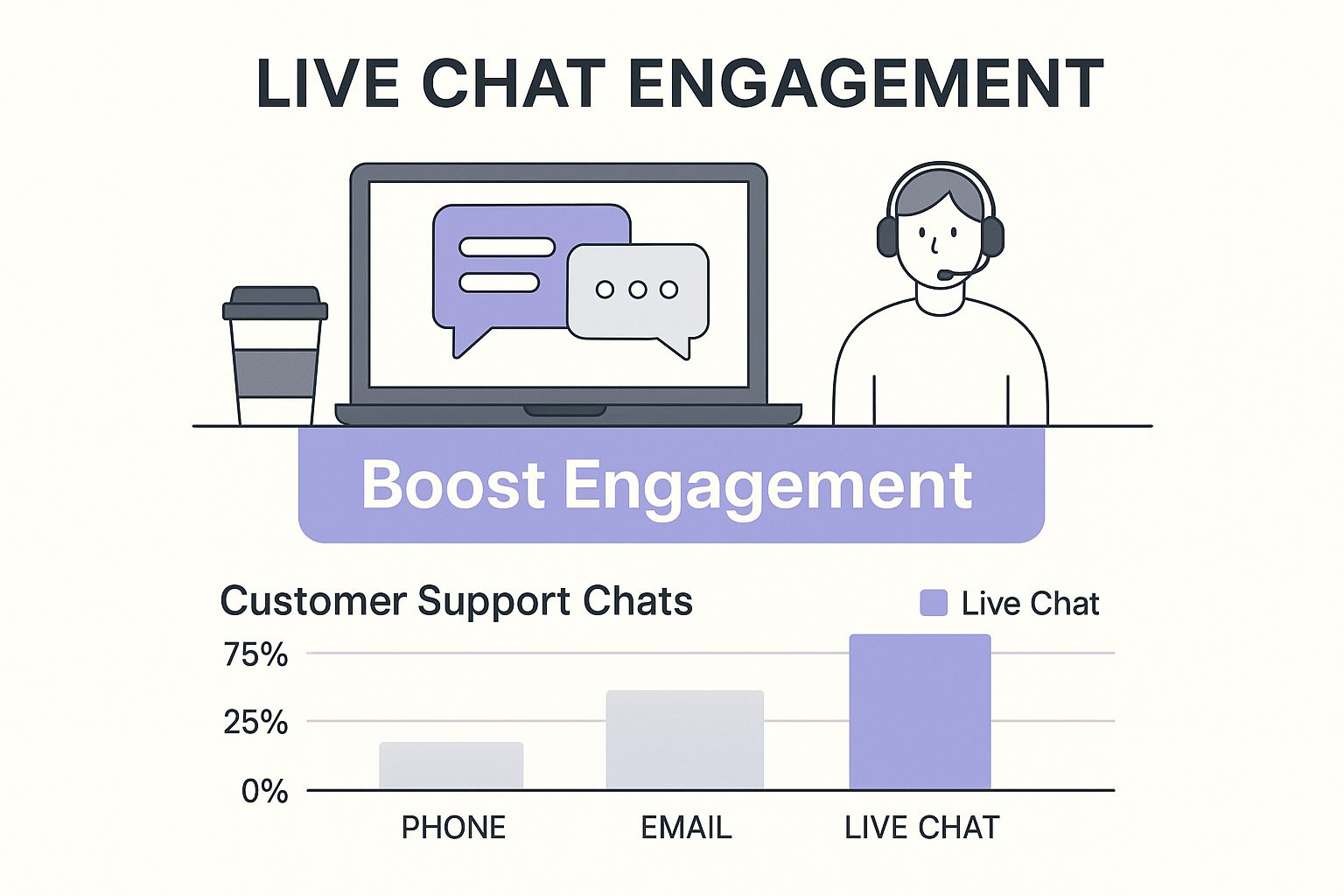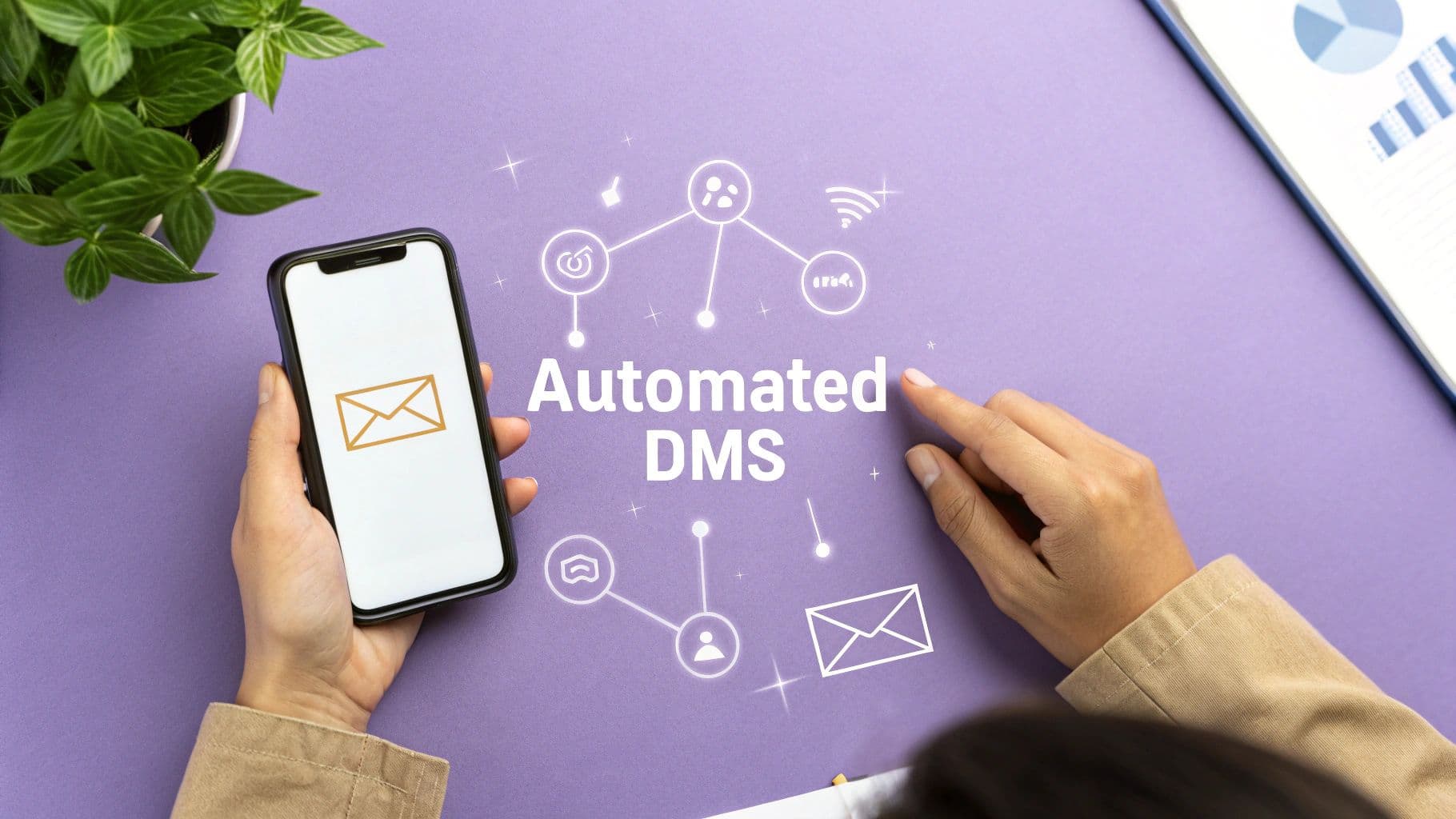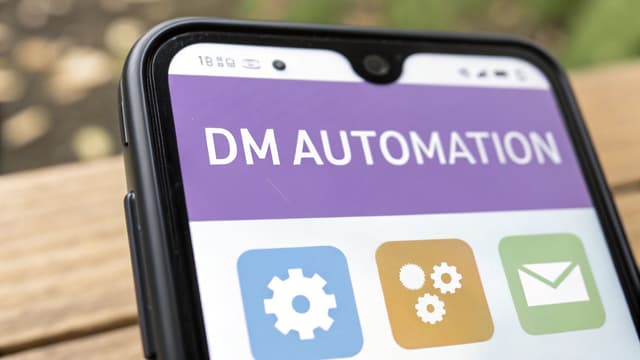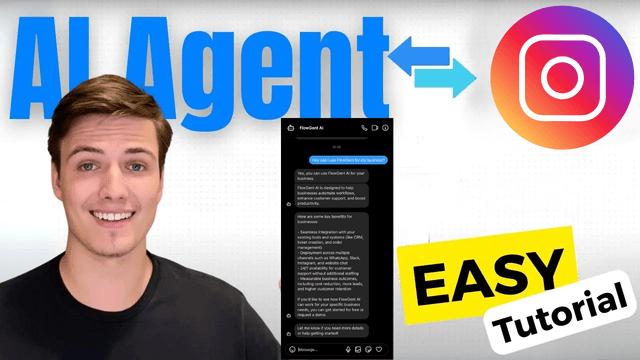Understanding Automated Direct Messages That Actually Work
Think of automated direct messages as your company's most reliable conversation starter—one that works around the clock, never misses a beat, and always knows the right thing to say. For comprehensive API pricing, integration, and setup details, check out our WhatsApp Business API guide. A well-designed automated message feels less like a corporate broadcast and more like a helpful text from a friend who happens to run your favorite brand. It's a direct, personal line of communication that cuts through the digital noise, which is precisely why it’s so effective.
These intelligent systems are now far more capable than simple "Thanks for following!" alerts. Today's platforms can manage complex, multi-step conversations that customers find genuinely helpful. Picture a system that doesn't just send a message but actually listens and reacts. For example, when someone comments on an Instagram to learn more about Instagram DM limits post about a new jacket, an automated DM can instantly follow up with a direct product link, answers to common questions, or even a special discount. This turns passive curiosity into an active, engaging experience. For more strategies on this, you can explore our guide on Instagram DM automation tool.
The Shift from Broadcasting to Conversing
Old-school marketing often felt like shouting into a canyon and hoping for an echo. You’d send out a mass email or post and just hope someone was paying attention. Automated direct messages completely flip that model on its head by creating one-on-one dialogues at a massive scale.
This conversational approach is why so many customers are opening up to business messaging. The numbers tell the story: by 2025, automated SMS marketing has become a go-to strategy for businesses globally. A remarkable 84% of consumers now opt-in to receive SMS messages from brands, marking a 35% increase from previous years. This jump signals a clear preference for direct, personalized contact. You can find more details about these texting and marketing statistics at SimpleTexting.com.
This change is all about the difference between interruption and interaction. A newsletter interrupts a person's day, but an automated DM often arrives as a direct result of an action they just took—making it feel timely and relevant. Context is everything.
Bridging Efficiency with a Personal Touch
The real magic of automated direct messages is how they fuse operational efficiency with a personal feel. Businesses can field thousands of inquiries without the quality of the conversation dropping. For example, a customer can ask about their order status via DM and get an immediate, accurate update pulled straight from your fulfillment system.
This is far more efficient than making them wait for a support agent and feels incredibly personal to the customer who gets their answer on the spot. To see how businesses can take this even further, look into how an automated text message service can elevate these interactions. In the end, smart companies are shifting resources to these direct channels because they know the future of customer loyalty is built one meaningful, automated conversation at a time.
The Performance Numbers That Change Everything
To really understand the power of automated direct messages, you need to look at the data. Traditional digital marketing channels are seeing their effectiveness stall or even drop, but direct messaging is now the clear frontrunner for customer engagement. The difference isn't small; it’s a fundamental shift in what businesses should expect from their outreach. It’s like comparing sending a letter by mail to making an instant video call—both are communication, but their speed and impact are worlds apart.
This huge performance gap comes down to human behavior. We are wired to see our direct message inboxes, whether on social media or SMS, as places for important, personal, and timely conversations. Because of this, messages we get there capture our immediate attention in a way that an email buried in a cluttered promotions tab never could. This infographic shows how automated DMs can boost engagement by connecting directly with this behavior.

As the visual highlights, adding automated chat into your workflow gives you a direct line to your audience, turning them from passive viewers into active participants. This immediate, interactive ability is what powers the impressive results we see across the board.
A Tale of Two Realities in Channel Performance
Let's attach some real numbers to this idea. While a great email campaign might get a 20% open rate, automated messaging is playing a completely different game. The data reveals that automated direct messages sent via SMS get remarkably high engagement. For instance, SMS messages have an open rate of about 98%, a number that dwarfs email's average of around 20-21.5%. This means for every 100 people you contact, 98 will see your SMS, while only about 21 will see your email. You can find more details in these SMS marketing statistics from Infobip.com.
It’s not just about getting seen; it’s about getting a reply. Response rates for automated DMs are also very high, often coming within minutes. This speed changes the entire customer experience. Answering a question in 90 seconds leaves a much better impression than a reply that takes 24 hours.
Comparing Automated DMs to Traditional Channels
To fully see the advantage, let's look at a direct comparison. The table below shows how automated direct messaging performs against more conventional marketing methods.
Automated Direct Messages vs. Traditional Marketing Channels Performance Comparison
A comprehensive comparison showing open rates, response times, and engagement metrics across different marketing channels
| Marketing Channel | Open Rate | Response Time | Engagement Rate | Cost Effectiveness |
|---|---|---|---|---|
| Automated DM (SMS/Social) | 90-98% | Under 5 minutes | Very High | High ROI due to conversion |
| Email Marketing | 20-25% | 24-48 hours | Moderate | Good for nurturing, lower direct response |
| Organic Social Posts | 5-10% reach | Varies widely | Low to Moderate | Cost-free but time-intensive, low reach |
| Paid Social Ads | N/A (Impressions) | N/A (Clicks) | Variable | Can be expensive, dependent on targeting |
The conclusion from this data is simple: if you want to start a conversation, solve a problem, or drive an immediate action, no channel works better than an automated direct message. This superior performance leads directly to better business results, from more lead conversions to higher customer satisfaction scores.
Smart Business Applications That Solve Real Problems

Beyond impressive open rates, the real magic of automated direct messages is how they solve specific, everyday business problems. They aren't just another way to send notifications; they're dynamic tools that create valuable moments all along the customer journey. Smart businesses use them to fix everything from frustrating support queues to lost sales, turning friction points into smooth, positive interactions.
Think about a busy healthcare practice struggling with no-shows—a common problem that costs the industry billions each year. Instead of having staff make generic reminder calls, they can use smart, automated DMs. An initial message confirms the appointment. Then, 24 hours before the visit, a second message asks for a simple "YES" to confirm or "RESCHEDULE" to get a link to an open calendar. This simple, automated chat dramatically cuts down on missed appointments and frees up staff.
This problem-solving mindset is what separates meaningful communication from digital noise. The key is to find those moments where an automated message can deliver genuine, timely help.
Creative Applications Across Industries
The power of automated direct messages isn't confined to a single industry. Businesses of all kinds are finding creative ways to apply this technology to their unique challenges.
-
E-commerce & Retail: A customer leaves items in their shopping cart. Instead of a generic email a day later, an automated DM pops up an hour later: "Hey [Name], did you have questions about the items in your cart? Happy to help!" This feels less like a sales tactic and more like personal customer service. Retailers can also send "back in stock" alerts for specific products, driving immediate sales from highly interested buyers.
-
Service-Based Businesses: A marketing agency can send an automated follow-up two weeks after finishing a project to ask for feedback. This not only gathers valuable testimonials but also shows the client they are still valued, strengthening the relationship for future business.
-
Lead Generation & Product Launches: For businesses building buzz, automated messages are a great way to manage and engage a growing audience. If you're creating a waitlist for a new product, you can find great strategies for waitlist success that work perfectly with automated communication.
Building a Customer Communication Ecosystem
Ultimately, these applications help build a connected communication system. Instead of viewing customer support, sales, and marketing as separate silos, automated direct messages bring them together. For example, when a customer DMs a question, an AI agent from a platform like FlowGent AI can provide an answer instantly.
This single interaction can solve a support ticket, prevent a lost sale, and reinforce brand loyalty all at once. For a closer look at this idea, you might be interested in our article on how to automate customer support.
By pinpointing these opportunities, businesses can create a fluid experience where customers feel heard and helped at every turn. It’s about building an entire omnichannel communication strategy that fosters trust and drives growth.
Market Forces Driving The Messaging Revolution
The rapid adoption of automated direct messages isn't a random event. It's the result of major changes in how people behave and what technology can do. These forces have created a situation where instant, direct communication isn't just a bonus—it's a baseline expectation. We are seeing a fundamental shift in how customers want to connect with businesses, and the market data paints a clear picture of this new reality.

This movement is powered by a few key drivers that smart businesses are watching closely. Understanding these factors is essential for any company looking to stay relevant and build strong customer relationships.
The Rise of the "Always-On" Consumer
Think about it: modern customers live on their phones, where messaging apps are a core part of their daily routine. They expect the same quick, easy interaction from a business that they get from texting a friend. The era of waiting on hold or sending an email into a black hole is fading fast. This desire for immediacy is a huge reason why automated direct messages are taking off.
- Instant Gratification: People want answers now, not hours or days later. A business that offers instant information or support through a DM gains a clear competitive edge.
- Conversational Preference: Most people prefer the natural, back-and-forth feel of a chat over the stiff, formal structure of emails or web forms.
- Mobile-First World: With most web traffic now on mobile devices, communication channels native to phones, like SMS and social media DMs, are the most effective.
Economic Impact and Market Growth
This change in preference is more than a social trend; it's a powerful economic engine reshaping industries. Businesses are investing heavily in messaging technology because they see a significant return. The economic effect of automated direct messages through channels like SMS is massive and growing. The global SMS marketing market is projected to reach $38.4 billion by 2030, expanding at a compound annual growth rate (CAGR) of 20.8%. You can dive deeper into these SMS marketing growth statistics on TxtCartApp.com. This financial momentum shows that automated messaging is a core business strategy, not just a passing fad.
Technological Enablers
At the same time, technology has matured to make advanced messaging automation available to companies of any size. It's no longer just for large corporations. Platforms like FlowGent AI have removed the complex technical hurdles that once stood in the way.
- AI and NLP: Artificial intelligence and Natural Language Processing (NLP) are the brains behind the operation, allowing automated systems to understand and respond to questions with surprising, human-like accuracy.
- Integration Capabilities: Today's tools can connect directly with your CRM, e-commerce platforms, and support desks. This enables conversations that are both personal and aware of the customer's history.
- Rich Media: The ability to send images, videos, and clickable buttons within a message makes the conversation more engaging and helpful than simple text.
These three forces—consumer demand, financial proof, and accessible technology—are all working together to make automated direct messages the new standard for how businesses and customers interact.
Getting Started With FlowGent AI Implementation
Putting theory into practice is where you'll see the real power of automated direct messages. Let's walk through how to set up a smart automation strategy using a platform like FlowGent AI. The idea is to create message flows that feel natural and genuinely helpful, not robotic. You don't need a coding background to build intelligent agents that manage customer chats well. The process is more about mapping out your customer's journey and designing a logical conversation.
The first step is to define your main goal. Are you trying to answer common questions, qualify new leads, or point users toward a specific product? Your objective will guide every part of the automation. For example, if you want to lower the number of support tickets, you’d start by listing the top five questions your team answers over and over. This list becomes the blueprint for your first automated flow, transforming a repetitive task into an instant, 24/7 solution.
Building Your First Automation Flow
Creating your first campaign is surprisingly simple. Think of it as building with digital LEGOs. You connect different blocks—triggers, actions, and messages—to put together a complete conversation. A trigger is the event that kicks off the automation. This could be a customer using a specific keyword in a comment, sending a DM, or mentioning your brand in a Story.
Here’s a practical, step-by-step way to launch a simple but effective automated message sequence:
- Define the Trigger: First, pick the action that will start the conversation. A common and very effective trigger is a keyword. For instance, you could ask followers to DM you the word "GUIDE" to get a free resource.
- Craft the Initial Response: As soon as the keyword is detected, the first message goes out. It should be immediate and personal. For example: "Hey [First Name]! Thanks for your interest. Here is the free guide you asked for." Using a first name makes the interaction feel more human.
- Design the Conversation Path: What comes next? You can add buttons to steer the user. After sending the guide, you might ask, "Did you have any other questions?" with "Yes" and "No" buttons. If they tap "Yes," you can direct them to another flow that answers common questions or connects them to a live agent.
- Integrate with Your Knowledge Base: A major feature of platforms like FlowGent AI is the ability to link to your existing help documents or FAQs. This allows the AI agent to pull answers straight from your trusted content, which ensures accuracy and consistency without you having to type in every possible answer by hand.
Visualizing the Workflow
Modern platforms offer visual builders that make this whole process intuitive. You can see the entire conversation map laid out right on your screen, which makes it easy to find gaps or add new branches to the dialogue.
The screenshot above displays a typical visual flow builder in FlowGent AI, where each box is a step in the customer's conversation. This visual interface simplifies the process, letting you drag and drop elements to design complex, multi-step automated direct messages that can handle a wide range of customer needs—all without any code.
Mastering The Art Of Automated Message Success
Success with automated direct messages isn’t measured by how sophisticated your technology is. It’s measured by how well you understand the person on the receiving end and whether you create an experience they genuinely find useful. Anyone can set up a simple trigger, but truly mastering this skill means separating welcomed, helpful messaging from the digital noise that erodes customer trust.
Think of it as the difference between a helpful store assistant who appears exactly when you need them and a relentless telemarketer who calls at random. The goal is to craft messages that feel personal and timely, even when they’re sent to thousands of customers. This requires a human-first approach to automation, making your audience feel seen and understood, not just processed by a machine.
Personalization And Timing: The Human Touch
True personalization is all about relevance. An automated message feels personal when it arrives at the perfect moment to address a specific, immediate need.
- Timing is Everything: Sending a discount code for a product a user just spent time looking at is helpful. Sending that same code randomly a week later feels like spam. Your automations should align with the customer's real-time actions. For instance, if someone comments on a post about your new product line, an immediate DM with a link to that collection is perfectly timed.
- Contextual Conversations: Your automated direct messages should be aware of where the user is in their journey. Did they just make a purchase? An order confirmation is expected and appreciated. Did they abandon their shopping cart? A gentle reminder, perhaps with an offer to answer questions, can bring them back. Each message should feel like the next logical step in a conversation.
To make these conversations even more effective, many businesses are implementing a chatbot that can handle these nuanced interactions with ease.
Avoiding Common Mistakes That Damage Trust
Even with the best intentions, it's easy to get automation wrong. A poorly executed campaign can be worse than doing nothing at all, actively pushing customers away.
One of the biggest mistakes is over-automating. People can spot a generic, canned response from a mile away. It’s critical to find the right balance between efficiency and authenticity. Use automation for routine tasks like answering frequently asked questions or confirming actions, but always provide a clear path for a user to reach a human for more complex or sensitive issues. A dead-end automated conversation is one of the fastest ways to lose a customer.
To help you get it right, here's a checklist of best practices to follow.
| Practice Category | Key Requirements | Common Mistakes | Success Metrics |
|---|---|---|---|
| Timing & Cadence | Send messages immediately following a trigger (e.g., comment, purchase). Avoid sending too many messages in a short period. | Random, untriggered messages. Bombarding users with multiple DMs in one day. | High open rates. Low block/report rates. |
| Personalization | Use user data (name, recent activity, purchase history) to tailor content. Acknowledge the user's specific action. | Using only the first name. Sending generic, one-size-fits-all messages. | High click-through rates (CTR). Increased engagement (replies). |
| Compliance & Consent | Get explicit consent before sending promotional DMs. Provide a clear and easy opt-out mechanism in every message. | Assuming consent. Hiding the unsubscribe option. Ignoring platform terms of service. | Low opt-out rates. Zero platform warnings or account suspensions. |
| Value & Utility | Ensure every message offers something useful: information, a discount, support, or entertainment. | Purely self-promotional content with no value to the user. Clickbait without delivering on the promise. | High conversion rates (sales, sign-ups). Positive customer feedback or replies. |
| Optimization | A/B test different message copy, offers, and calls-to-action. Monitor analytics and adjust strategy accordingly. | "Set it and forget it" mentality. Not tracking performance or iterating based on data. | Improvement in CTR, conversion rates, and engagement over time. |
| Human Handoff | Have a clear pathway for users to connect with a human agent when the automation can't help. | Creating automated loops with no escape. Ignoring requests to speak to a person. | High customer satisfaction scores (CSAT). Resolution of complex support tickets. |
This checklist serves as a guide to ensure your automated DMs are helpful, respectful, and effective. By focusing on these areas, you can build a strategy that strengthens customer relationships instead of damaging them.
The Foundation Of Success: Compliance And Respect
Finally, every successful automated messaging strategy is built on a foundation of respect and compliance. This means being transparent about how you handle data and strictly following each platform's terms of service and privacy rules. Always get clear consent before adding users to any messaging list, and make it simple for them to opt out.
Building this trust is non-negotiable. It not only protects your business from potential penalties but also shows your customers you value their privacy as much as you value their business.
Your Action Plan for Automated Message Excellence
Turning a great idea into a real-world solution is where the magic happens. This section is your roadmap, breaking down how to implement automated direct messages into clear, manageable steps. Whether you're starting from scratch or refining what you already have, the secret is to begin with a single, high-impact goal. This approach delivers a quick win and builds momentum for future projects. Don't try to automate everything at once; focus on solving one significant pain point first.
Phase 1: Assess and Identify (Weeks 1-2)
Before you start building, you need a solid blueprint. This first phase is all about taking an honest look at your current processes to find the best opportunities for automation.
- Audit Your Current Communications: Take a close look at how you interact with customers now. Where are the biggest delays or repetitive tasks? Is it answering the same questions over and over, qualifying new leads, or following up after a sale? Make a list of the top 5-10 most common tasks your team handles manually.
- Pinpoint Your First Target: From that list, choose the single biggest problem you can solve with automation. A fantastic starting point is often an FAQ agent. It provides immediate value by offering instant, 24/7 answers, which frees up your team and makes customers happier.
- Define Your Success Metric: What does a win look like for this project? It could be cutting down support ticket volume by 20%, boosting lead qualification rates by 15%, or simply seeing a jump in customer satisfaction scores. Set a clear, measurable goal to track your progress.
Phase 2: Build and Test (Weeks 3-4)
With a clear goal in mind, it's time to build your first automated message flow. The key here is to keep it simple and functional.
- Map the Conversation: Grab a whiteboard or open a document and sketch out the ideal conversation. What event triggers the automation (like a user typing "support")? What are the key decision points and likely user responses? Simplicity is your friend here.
- Build the Basic Flow: Using a platform like FlowGent AI, bring your conversation map to life. Write clear, concise messages that sound like your brand. Most importantly, always include an easy way for a user to connect with a human if the automation can't solve their problem.
- Conduct Internal Testing: Before you launch, have your team test the flow thoroughly. Encourage them to try and break it with unexpected questions. This internal feedback is crucial for catching errors and polishing the experience before it reaches your customers.
Phase 3: Launch and Optimize (Ongoing)
Once your first automated flow is live, the work shifts from building to improving. This is a continuous cycle of learning from real-world data and making things better.
- Monitor Performance: Check your analytics regularly. Are users getting through the flow successfully? Where are they getting stuck or dropping off? Use this information to find and fix any rough spots.
- Gather User Feedback: Pay close attention to how people interact with your agent. You can even add a simple feedback prompt at the end of the conversation, like, "Was this helpful? (Yes/No)".
- Iterate and Expand: Based on what you learn, make small, steady improvements. Once your first agent is running smoothly and delivering results, you can identify the next problem to tackle, gradually building out your ecosystem of automated direct messages.
Ready to turn your action plan into reality? Discover how FlowGent AI can help you build and launch your first intelligent agent in minutes, transforming your customer communication from a cost center into a growth engine.


